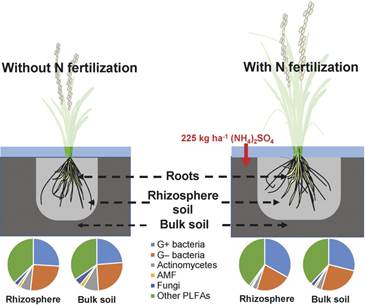

根际沉积过程可为土壤微生物提供易于利用的碳源和能源,其在生态系统中调节土壤碳和养分循环中起重要作用,并对碳的固定作用产生强烈影响。水稻根际碳在水稻生长过程中的动态变化过程及其在微生物群落中的分配以及氮肥对该过程的影响机制尚不清楚。研究稻田土壤中水稻根际碳氮循环及其对微生物群落结构的调节有利于科学指导合理施肥和促进稻田土壤的可持续发展。
基于此,中国科学院亚热带农业生态研究所研究人员通过水稻多生育期的联合脉冲标记(13CO2)结合13C-PLFA-SIP技术,探讨了施氮对水稻不同生育期光合碳(通过根际沉积作用)在微生物群落中的分配特征,阐明了水稻根际沉积碳在水稻不同生育期内的周转特征。结果表明,G+和G-细菌是同化根际沉积碳的初始微生物,他们负责将根际碳周转到水稻土壤中的其他的微生物群落中。微生物对根际沉积碳利用的变化和土壤微生物群落的演替主要发生在水稻生长的早期阶段,反映了根际沉积的变化。此外,氮肥施用可以改变根际沉积物对微生物组成的影响,这主要体现在G+细菌的增加,这可能会促进根际沉积碳从根际向非根际转移。该研究揭示了水稻光合碳向土壤微生物快速转移的现象,也为水稻地上部的光合作用和地下部的微生物活动之间的定量关系奠定了理论基础(图1,2)。
该项研究近期以Initial utilization of rhizodeposits with rice growth in paddy soils: Rhizosphere and N fertilization effects 为题发表在Geoderma上。该研究得到国家重点研发项目、国家自然科学基金、亚热带生态所青年创新团队项目以及博士后国际交流计划项目的资助。(来源:中国科学院亚热带农业生态研究所)
Initial utilization of rhizodeposits with rice growth in paddy soils: Rhizosphere and N fertilization effects
Abstract Rhizodeposition represents a readily available C and energy source for soil microorganisms, that plays an important role in the regulation of C and nutrient cycling in ecosystems and exerts a strong influence on C sequestration. The dynamics of rice rhizo-C in soils and its allocation to microorganisms during rice growth, as well as the effects of nitrogen (N-NH4+) fertilization are poorly understood, particularly with respect to the initial uptake of rhizo-C by microorganisms and its utilization during the entire growth period. To assess these two processes, rice plants were grown in pots with or without N fertilization (0 and 225?kg?N-NH4+?ha?1), and 13C incorporation into microbial groups was traced by phospholipid fatty acids(PLFAs) analysis within 6?h after 13CO2 pulse labeling. Labeling was performed at five growth stages: tillering, elongation, heading, filling, and maturation. 13C incorporated into soil microbial biomass C changed rapidly at the beginning of the study period, before elongation, but remained stable thereafter. 13C incorporation into rhizosphere and bulk soil microbial biomasswas higher with than without N addition. This stimulation was likely due to the excessive increase in phytomass formation and root exudates after N fertilization and the increased assimilate C input into the soil. Structural equation modelling suggested that N fertilization strongly affected carbon transfer between rhizosphere and non-rhizosphere. Hence, N-NH4+application may not only increase rhizo-C flow into microorganisms but it may also increase the effect of rhizosphere on bulk-soil microorganisms and subsequent processes related to soil C-cycling.
原文链接:https://www.sciencedirect.com/science/article/pii/S0016706118307493



